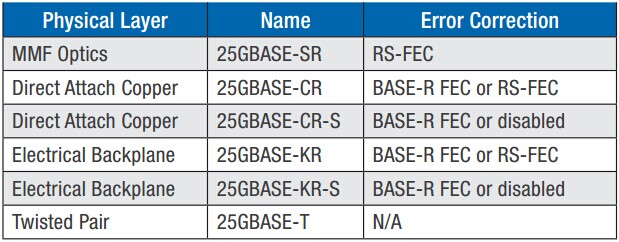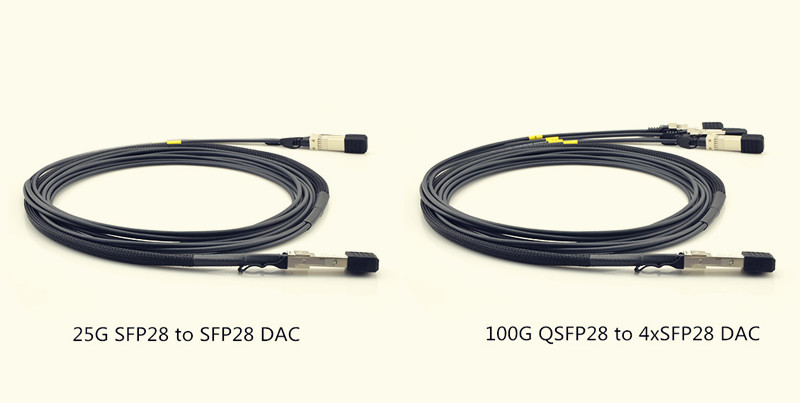As the increasing bandwidth requirements of private and public cloud data centers and communication service providers, 25Gbps Ethernet over a single lane will have a significant impact on server interconnect interfaces. It may become the new upgrade path to 100G (10G-25G-100G instead of 10G-40G-100G). This article will give brief introduction about 25GbE Ethernet.
What’s 25GbE Ethernet
25GbE Ethernet standard is proposed for connectivity in the data centers. Because of the increasing demand for higher speed network performance and maintaining Ethernet economics, IEEE agreed to support the development of 25GbE standard in June 2014. 25G Ethernet is defined for 100GbE implemented as four 25Gbps lanes running on four fiber or copper pairs. 100G Quad small for-factor pluggable transceiver (QSFP28) have four lasers, each transmitting 25Gbps. The twisted pair pair standard was derived from 40GbE standards development. The following table shows the main upcoming interfaces for 25Gbps.

Number of Lanes 40G QSFP+ interface is constructed from four parallel links. Extending QSFP+ onto fiber requires four parallel 10Gb streams to transport this to the receiving QSFP+ parallel optics. The data transmission is achieved by four lanes which significantly reduce switch port density per switching chip and increases the cost of cabling and optics. While the 25GbE standard requires only a single lane, while delivering 2.5 times more throughput compared to current 10GbE solutions and significantly saving the cost compared to 40GbE solutions.
Form Factors The 25GbE physical interface specifications support the form factors including QSFP28 and SFP28. QSFP28 has four lanes and each lanes supports 25 Gbps speed. SFP28 has only one lane and it also supports 25 Gbps speed. Current switch doesn’t support 25G SFP28 port. So the solution for 25G is to use a breakout cable that allows four 25GbE ports to connect to a 100GbE QFSFP28 switch port.
Benefits of 25GbE Ethernet
First, more data and switch port density. Compared with 10G solution, 25GbE standard can provide 2.5 times more data. And it can also offer 4 times switch port density compared to 40G solution. Second, save the cost. Since it can provide greater port density, fewer ToR switches and cables are needed. In that way, it reduces the construction cost compared with 40GbE. Third, it features lower power and smaller footprint requirements. Due to these special benefits, 25GbE is believed to be popular in no time. According to a recent five-year forecast, it’s said that annual shipments of 25GbE ports will be 2.5 times greater than 40GbE ports by 2018.

25G Solutions
Fiberstore (FS.COM) has released 25G DAC (direct attach copper) cables which include 100G QSFP28 to 4xSFP28 and 25G SFP28 to SFP28 with the length from 1 m to 5 m. QSFP28 refers to the 100G DAC cable using the QSFP+ form factor, and SFP28 refers to the 25G DAC cable using the SFP+ form factor. The form factor remains the same but the new standard will require improved cables and connectors capable of handling additional bandwidth. Existing QSFP+ and SFP+ cable assemblies are not compatible with QSFP28 and SFP28 ports. 25G DAC is designed as the low-cost copper connection for ToR switches.

It’s certain that Fiberstore will soon release 25GBASE-T interface equipment. 25GBASE-T can support 30 meters long reach with low cost. It’s a cost-effective solution for ToR server connections using point-to-point patch cords, and enable End of Row (EoR) or Middle of Row (MoR) by using the 30 meter structured cabling. The connection can be achieved with the common use of RJ45 plug and connector. Compared with 25G DAC, it seems to be a more suitable way.
Conclusion
25GbE can provide up to 2.5 times faster performance than existing 10GbE connections while maximizing the Ethernet controller bandwidth/ pin and switch fabric capability. It can also provide greater port density with lower cost compared to 40GbE solutions. It’s analyzed that 25G will limit the deployment of 40G QSFP+ ports. By now, FS.COM has released 100G QSFP28 to 4xSFP28 and 25G SFP28 to 25G SFP28 DAC cables for 25G network. In the near future, there will more equipment for 25G including 25GBASE-T transceiver. Let’s look forward to it.
Originally published at www.fiber-optic-equipment.com
No comments:
Post a Comment